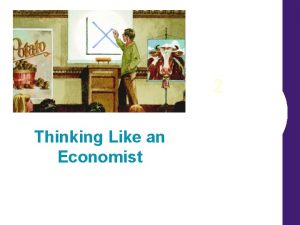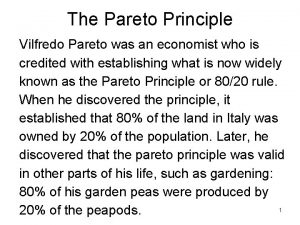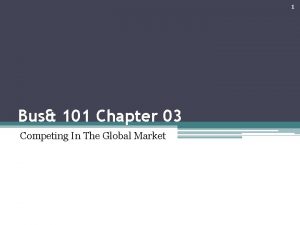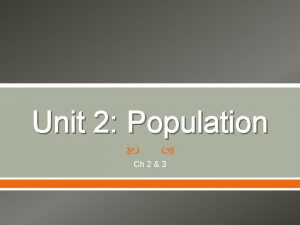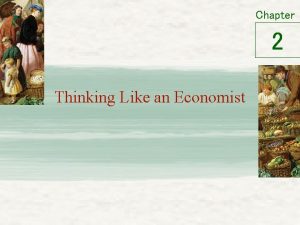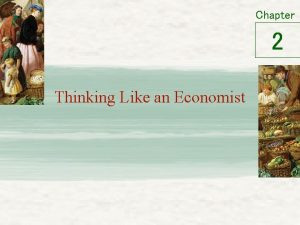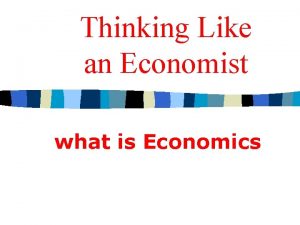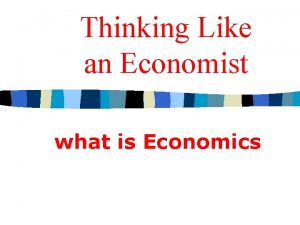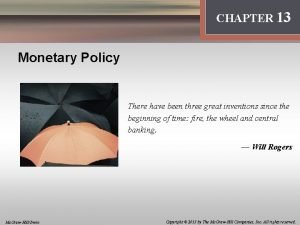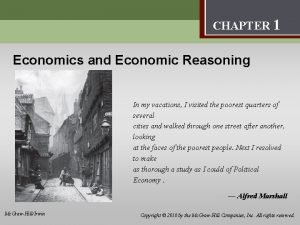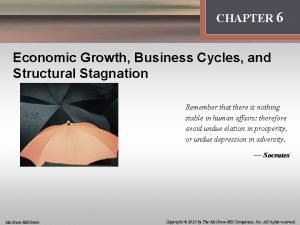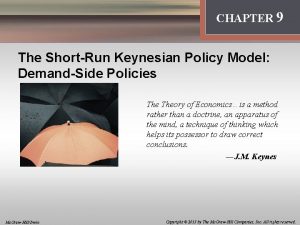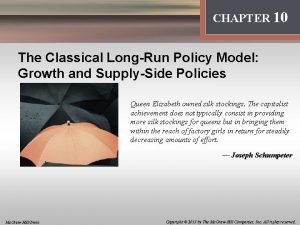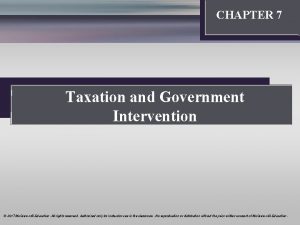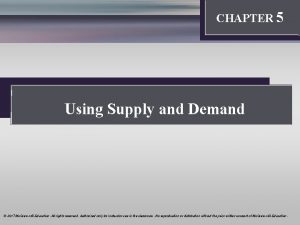Introduction Thinking Like an Economist CHAPTER 7 Measuring
















- Slides: 16

Introduction: Thinking Like an Economist CHAPTER 7 Measuring the Aggregate Economy The government is very keen on amazing statistics…They collect them, add them, raise them to the nth power, take the cube root and prepare wonderful diagrams. But you must never forget that every one of these figures comes in the first instance from the village watchman, who just puts down what he damn pleases. — Sir Josiah Stamp (head of Britain’s revenue department in the late 19 th century) Mc. Graw-Hill/Irwin Copyright © 2013 by The Mc. Graw-Hill Companies, Inc. All rights reserved.

Measuring the Aggregate Economy 17 Chapter Goals Ø Calculate GDP using the expenditures and value added approaches Ø Calculate aggregate income and explain how it relates to aggregate production Ø Distinguish real from nominal concepts Ø Describe the limitations of using GDP and national income accounting 7 -2

Measuring the Aggregate Economy 17 Aggregate Accounting Ø Aggregate accounting (or national income accounting) is a set of rules and definitions for measuring economic activity in the economy as a whole Ø Aggregate accounting is a way of measuring total, or aggregate production, expenditures, and income Ø Gross domestic product (GDP) is the total market value of all final goods and services produced in an economy in a one-year period 7 -3

Measuring the Aggregate Economy 17 The Components of GDP Ø GDP is divided into four expenditure categories: 1. Consumption (C) is spending by households on goods and services 2. Investment (I) is spending for the purpose of additional production 3. Government spending (G) is goods and services that government buys 4. Net exports is spending on exports (X) minus spending on imports (M) GDP = Consumption + Investment + Government spending + Net exports GDP = C + I + G + (X-M) 7 -4

Measuring the Aggregate Economy 17 GDP Measures Final Output Ø GDP does not measure total transactions in the economy Ø It counts final output, but not intermediate goods • Final output is goods and services purchased for final use • Intermediate products are used as an input in the production of some other product Ø Counting the sale of both final and intermediate goods would result in double counting 7 -5

Measuring the Aggregate Economy 17 Two Ways of Eliminating Intermediate Goods Ø Calculate only final output • A firm would report how much it sold to consumers and how much it sold to producers (intermediate goods) Ø Follow the value added approach • Value added is the increase in value that a firm contributes to a product or service • It is calculated by subtracting intermediate goods (the cost of materials that a firm uses to produce a good or service) from the value of its sales 7 -6

Measuring the Aggregate Economy 17 Gross and Net Concepts Ø Net domestic product is GDP adjusted for depreciation, • Depreciation is the amount of capital used up in producing that year’s GDP • NDP measures output available for purchase NDP = C + I + G + (X-M) – depreciation Ø Net Investment is gross investment minus depreciation 7 -7

Measuring the Aggregate Economy 17 National and Domestic Concepts Ø GDP is the total value of all final goods and services produced in an economy in a one-year period • GDP is output produced within a country’s borders Ø Gross National Product (GNP) is the aggregate final output of citizens and businesses of an economy in one year • GNP is output produced by a country’s citizens • GNP = GDP + Net foreign factor income Ø Net foreign factor income is the income from foreign domestic factor sources minus foreign factor income earned domestically 7 -8

Measuring the Aggregate Economy 17 Calculating Aggregate Income Ø Aggregate income is the total income earned by citizens and businesses in a country in a year Ø Aggregate income consists of: • Employee compensation • Rent • Interest • Profits Ø Aggregate income = Employee compensation + Rents + Interest + Profits 7 -9

Measuring the Aggregate Economy 17 Equality of Aggregate Income and Aggregate Production Ø Whenever a good or service is produced (output), somebody receives an income for producing it Aggregate Income ≡ Aggregate Production Ø Profit is a residual that makes the income side equal the expenditures side Ø This aggregate identity allows us to calculate GDP either by adding up all values of final outputs (C, I, G, net exports) or by adding up the values of all earnings or income Ø As globalization has expanded, net exports have become increasingly important 7 -10

Measuring the Aggregate Economy 17 Real GDP, Nominal GDP and Price Indices Ø Nominal GDP is GDP calculated at current prices Ø The GDP deflator is a price index GDP deflator = Nominal GDP X 100 Real GDP Ø Real GDP is nominal GDP adjusted for inflation Real GDP = Nominal GDP deflator/100 7 -11

Measuring the Aggregate Economy 17 Other Real and Nominal Distinctions Ø Nominal interest rate is the rate you pay or receive to borrow or lend money Ø Real interest rate is the nominal interest rate adjusted for inflation Real interest rate = Nominal interest rate – Inflation rate 7 -12

Measuring the Aggregate Economy 17 Other Real and Nominal Distinctions Ø Real wealth is the value of the productive capacity of the assets of an economy measured by the goods and services it can produce now and in the future Ø Nominal wealth is the value of these assets measured in current prices Ø Asset price inflation is a rise in the price of assets unrelated to increases in their productive capacity 7 -13

Measuring the Aggregate Economy 17 Some Limitations of Aggregate Accounting Ø GDP measures economic activity, not welfare • GDP does not measure happiness, nor does it measure economic welfare Ø Measurement problems exist • Measurements of inflation can involve significant measurement errors Ø Subcategories are often interdependent • For example, the line between consumption and investment may be unclear 7 -14

Measuring the Aggregate Economy 17 Some Limitations of Aggregate Accounting Ø Measurement is necessary, and the GDP measurements and categories have made it possible to think and talk about the aggregate economy Ø The genuine progress indicator (GPI) makes a variety of adjustments to GDP to better measure the progress of society rather than just economic activity • The GPI includes social goals such as pollution reduction, education, and health 7 -15

Measuring the Aggregate Economy 17 Links for Measuring the Economy Genuine Progress Indicator: Genuine Progress UN Millennium Development Goals Report: UN MDG Report 7 -16
 Thinking like an economist chapter 2
Thinking like an economist chapter 2 Thinking like an economist chapter 1
Thinking like an economist chapter 1 Chapter 2 thinking like an economist summary
Chapter 2 thinking like an economist summary Chapter 2 thinking like an economist
Chapter 2 thinking like an economist Thinking like an economist chapter 2
Thinking like an economist chapter 2 Thinking like an economist summary
Thinking like an economist summary Thinking like an economist ppt
Thinking like an economist ppt Lower outer fence
Lower outer fence Planned economy or planned destruction political cartoon
Planned economy or planned destruction political cartoon Eoc a sample
Eoc a sample What does the man on the park bench represent
What does the man on the park bench represent The young economist's guide to professional etiquette
The young economist's guide to professional etiquette Jane carter labor economist
Jane carter labor economist Economist.com
Economist.com Economist.com
Economist.com Economist china trade
Economist china trade Tradgedy of the commons
Tradgedy of the commons





